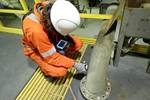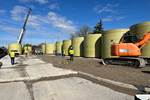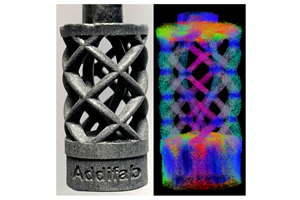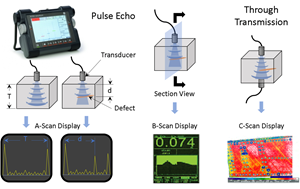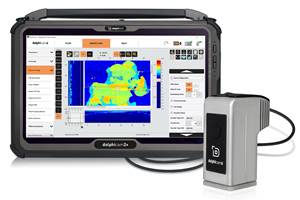UTComp methodology enables nondestructive evaluation of phosphoric acid FRP piping system
Recent customer case study involved repeatable and scalable assessment of FRP composite pipes’ mechanical integrity via its UltraAnalytix NDT system.
A technician takes UltraAnalytix readings of a section of FRP piping used to transport phosphoric acid. Source (All Images) | UTComp
Project managers planning the expansion of a large phosphoric acid plant in the Middle East engaged UTComp Inc. (Cambridge, Ontario, Canada) to assess the condition of existing fiber-reinforced polymer (FRP) pipeline systems at the facility.
UTComp’s assessment involved examining two side-by-side, 100-300 millimeter-diameter phosphoric acid pipelines each about five kilometers long and designed for operating pressures of 1,000 kPa. The pipes — an export line and an emptying line — are used to transport acidic solutions from various parts of the plant to a port storage facility where phosphoric acid is loaded onto ships for export. Some sections of pipe had been in service since the late 1990s, while other sections were installed in 2009.
The chemical manufacturing plant has a daily production capacity of more than 1,300 tonnes of phosphoric acid. The plant uses a wet process in which crushed phosphate rock is mixed with sulphuric acid. The acid mixture is then concentrated and purified for export and use in a variety of applications such as fertilizers, food additives, cleaning products and more.
While not generally considered a strong acid, in higher concentrations phosphoric acid may attack metals. The plant is located in a desert coastal area, where harsh environmental conditions can damage infrastructure through a combination of extreme heat, humidity fluctuations, sand and salt. Filament-wound, FRP composite pipes have a distinct advantage in such applications, as the material has a long record of success safely transporting and storing materials such as corrosive acids where steel and other alloys are unsuitable or cost prohibitive.
For this particular application, UTComp’s inspection team divided each pipe into 100-meter sections, following UTComp standard practices.
However, nondestructive testing (NDT) of FRP piping is relatively new. Conventional inspection approaches, including destructive testing and visual inspections that typically require confined space entry, are not well-suited to assessing pipeline networks due to the small diameter of the equipment and the vast amount of piping snaking through a typical facility. Regular visual external inspections are important but provide only limited insight.
This is where UTComp’s UltraAnalytix NDT can come into play. The nondestructive, nonintrusive assessment system is reported to provide a reliable, repeatable and scalable method for inspecting in-service FRP pipelines and ensuring their safe performance and maximum lifespan. The system also provides trained inspectors with the tools they need to assess Fitness for Service by efficiently gathering data to accurately calculate FRP thickness and determine corrosion barrier condition anywhere along a piping circuit, calculate the percentage of design stiffness (PDS) and estimate remaining service life (RSL).
For this particular application, UTComp’s inspection team divided each pipe into 100-meter sections, following UTComp standard practices: As each ultrasonic survey was completed, an external inspection was also completed to identify surface damage such as cracks; UV damage; gouges, blisters or other deformation; corrosion damage to supports; condition of flanges, nozzles, lugs and repads; disbonding or peeling; and more.
Results were presented as Circuit Reports that included a description of condition monitoring locations (CMLs), the results of ultrasonic inspections at CMLs, minimum RSL and a summary of the findings of the external inspection.
The assessment revealed some corrosion barrier damage plus evidence of leaks and corrosion damage to clamps, joints, supports and other key components that needed repair. However, in general, the FRP piping systems were in good condition with a RSL exceeding 6 years in most sections of the facility.
According to UTComp, this case study demonstrates how its UltraAnalytix NDT system provides quantifiable knowledge about the condition of FRP at any age — new or in-service — by monitoring the changes that take place within the material’s structure. These changes can be used as the basis for repair and replacement planning.
Read the complete case study here.
Related Content
Xnovo Technology, Exciscope introduce X-ray tensor tomography technique
Through a strategic partnership, the companies introduce the FiberScanner3D module, dedicated to bringing more rapid, reliable and robust fiber structure characterization methods to lab settings.
Read MoreNondestructive inspection methods available to composites manufacturers
An overview of composite laminate inspection techniques ranging from manual testing methods to more advanced, noncontact options.
Read MorePortable digital ultrasonic imaging achieves in-service, field and manufacturing inspection
CAMX 2023: 2D array ultrasonic NDT for composites, metals and other materials is made possible through Dolpitech’s dolphicam and dolphicam2+ matrix transducer technology.
Read MoreRobotic NDT inspection solutions, services enhance multitasking capabilities
CAMX 2024: Matec Instrument Companies Inc. presents its range of nondestructive ultrasonic testing technologies, including robotic inspection systems for increased efficiency and reduced physical strain.
Read MoreRead Next
Strohm, Unitech Offshore to deliver integrated TCP subsea pipeline
Use of Unitech connectors and Strohm composite pipes will achieve flange-less end-to-end subsea jumper connection system, simplifying installation and ensuring long-lasting performance.
Read MoreUTComp announces ASNT-compliant certification program for UltraAnalytix inspection personnel
The UltraAnalytix inspection system is an ultrasonic NDT method providing Fitness-For-Service assessments for FRP composites by inspectors who are certified in accordance with ASNT SNT-TC-1A practice.
Read MoreLarge-diameter composite pipe repairs Detroit sewage system
QuakeWrap's 16-foot-diameter FRP pipes will transfer more than half of Detroit's sewage from a pump station.
Read More


